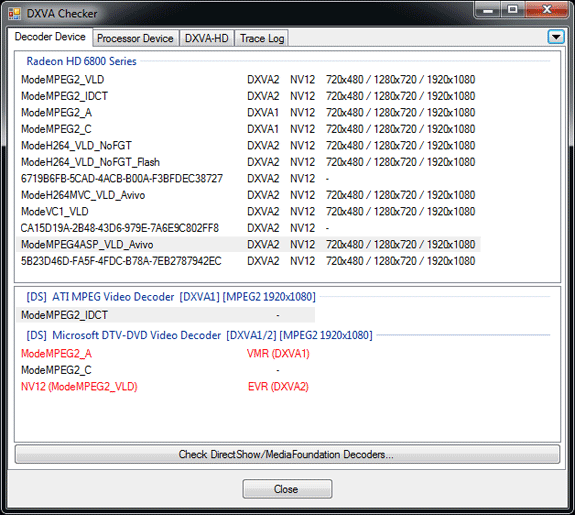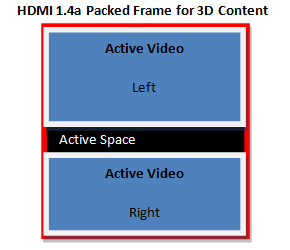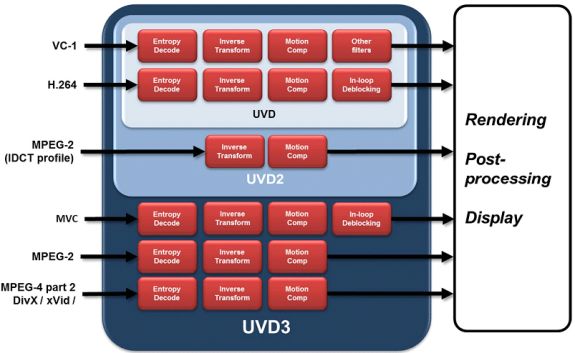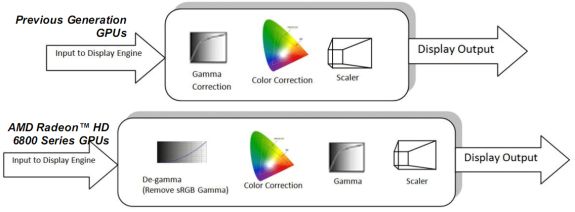AMD’s Radeon HD 6870 & 6850: Renewing Competition in the Mid-Range Market
by Ryan Smith on October 21, 2010 10:08 PM ESTSeeing the Present: HDMI 1.4a, UVD3, and Display Correction
DisplayPort wasn’t the only aspect of AMD’s display controller that got an overhaul however, AMD’s HDMI capabilities have also been brought up to modern standards. Coming from Cypress with support for HDMI 1.3, AMD now supports HDMI 1.4a on the Barts based 6800 series and presumably they will do so on the rest of the 6800 series too. With HDMI 1.4a support AMD can now support full resolution (1080p) 3D stereoscopy for movies, and 720p for games and other material that require 60Hz/eye, along with 4k x 2k resolution for monitors and TVs that have equivalent support. Unlike DP this has less to do with monitors and more to do with TVs, so the importance of this will be seen more on future AMD cards when AMD refreshes their lower-end parts that we normally use with HTPCs.
Launching alongside support for displaying full resolution 3D stereoscopic video is the hardware necessary to decode such video, in the form of the latest version of AMD’s Unified Video Decoder: UVD3. The last time UVD received a major update was with UVD2, which launched alongside the Radeon HD 4000 series and added partial MPEG-2 decoding support by moving IDCT and MoComp from shaders in to the UVD fixed function hardware.
With the Radeon 6800 series AMD is releasing UVD3, which like UVD2 before it builds on the existing UVD feature set. UVD3 is adding support for 3 more-or-less new codecs: MPEG-2, MVC, and MPEG-4 ASP (better known as DivX/XviD). Starting with MPEG-4 ASP, it’s the only new codec in supported by UVD3 that’s actually new, as previously all MPEG-4 ASP decoding was done in software when it came to AMD GPUs. With UVD3 AMD can now completely offload MPEG-4 ASP decoding to the GPU, bringing forth the usual advantages of greatly reducing the amount of work the CPU needs to do and ideally reducing power consumption in the process.
AMD adding MPEG-4 ASP support gives us an interesting chance to compare and contrast them to NVIDIA, who added similar support a year ago in the GT21x GPUs. AMD is a good bit behind NVIDIA here, but they’re making up for it by launching with much better software support for this feature than NVIDIA did; NVIDIA still does not expose their MPEG-4 ASP decoder in most situations, and overall did a poor job of advertising it. When we talked with DivX (who is AMD’s launch partner for this feature) they didn’t even know that NVIDIA had MPEG-4 ASP support. Meanwhile AMD is launching with DivX and had a beta version of the DivX codec with UVD3 support ready to test, and furthermore AMD is fully exposing their MPEG-4 ASP capabilities in their drivers as we see in this DXVA Checker screenshot.

The only downside at this time is that even with Microsoft’s greater focus on codecs for Windows 7, Windows 7 doesn’t know what to do with DXVA acceleration of MPEG-4 ASP. So while Win7 can play MPEG-4 ASP in software, you’re still going to need a 3rd party codec like the DivX codec to get hardware support for MPEG-4 ASP.
The other bit worth mentioning is that while AMD is launching support for MPEG-4 ASP decoding here on the 6800 series, much like HDMI 1.4a it’s not going to be a big deal for the 6800 series market. MPEG-4 ASP is a fairly lightweight codec, so support for it is going to be a bigger deal on low-end products, particularly AMD’s APUs if Llano and Bobcat end up using UVD3, as MPEG-4 ASP decoding in software requires a much greater share of resources on those products.
Up next is MPEG-2, which has been a codec stuck in limbo for quite some time over at AMD. MPEG-2 is even older and easier to decode than MPEG-4 ASP, and while GPUs have supported MPEG-2 decode acceleration as early as last decade, CPUs quickly became fast enough that when combined with low levels of hardware decode acceleration (inverse discrete cosine transform) was more than enough to play MPEG-2 content. Thus AMD hasn’t done much with MPEG-2 over the years other than moving IDCT/MoComp from the shaders to UVD for UVD2.
Because of the similarities between MPEG-4 ASP and MPEG-2, when AMD added support for full MPEG-4 ASP decode acceleration they were able to easily add support for full MPEG-2 decode acceleration, as they were able to reuse the MPEG-4 ASP entropy decode block for MPEG-2. As a result of including full MPEG-4 ASP decode acceleration, AMD now supports full MPEG-2 decode acceleration. Even more so than MPEG-4 ASP however, the benefits for this are going to lie with AMD’s low-end products where getting MPEG-2 off of the CPU should be a boon for battery life.

The final addition to UVD3 is support for Multiview Video Coding, which isn’t a new codec per se, but rather is an extension to H.264 for 3D stereoscopy. H.264 needed to be amended to support the packed frame formats used to store and transmit 3D stereoscopic videos, so with UVD3 AMD is adding support for MVC so that UVD can handle Blu-Ray 3D.
Finally, coupled with support for new codecs and new display outputs in AMD’s display controller is a refinement of AMD’s existing color correction capabilities in their display controller. Cypress and the rest of the 5000 series could do color correction directly on their display controllers, but they could only do so after gamma correction was applied, meaning they had to work in the non-linear gamma color space. Technically speaking this worked, but color accuracy suffered as a result. With the 6800 series’ new display controller, AMD can now perform color calibration in linear space by converting the image from gamma to linear color space for the color correction, before converting it back to gamma color space for display purposes.
As color correction is being used to correct for wide-gamut monitors the importance of this change won’t be seen right away for most users, but as wide-gamut monitors become more widespread color correction becomes increasingly important since wide-gamut monitors will misinterpret the normal sRGB colorspace that most rendering is done in.












197 Comments
View All Comments
Finally - Friday, October 22, 2010 - link
Did you have a look at the games market lately? Noticed all those shabby console ports? There is no progress because the graphics power of an XBOX or PS3 is exactly the same as it has been when they were introduced.Then again, who wants to play dumbed-down console games, made by illiterates for illiterates running on antique hardware which severely limits innovation in the graphics sector?
jimhsu - Friday, October 22, 2010 - link
"I know the 4890 is a pig (loud, noisy, power hungry) compared to the cards here"And hence your point. Essentially, major COMPUTER manufacturers (not just video card makers) simply are less concerned about maximum performance anymore -- for 95% of the population, what we have now is "good enough", and for the remaining 5%, getting more of the cheap stuff is also "good enough" (HPC builders, SLI/CrossFire, etc). Instead, people look at things like "is this quiet" (heat production, fans) or "what does this mean for my bottom line" (power consumption, replacability). The age of the monolithic "fast chip" is over.
Jamahl - Friday, October 22, 2010 - link
AMD naming the cards the 6800 series or Anandtech changing their policy of not reviewing overclocked cards.spigzone - Saturday, October 23, 2010 - link
AMD renaming their cards = more confusingAnandtech 'changing' their policy = more inexplicable.
softdrinkviking - Friday, October 22, 2010 - link
i join the throngs of disgruntled consumers that object to the new naming convention of the 6800 series.it's silly and stupid, and you should be ashamed of your collective AMD selves.
spigzone - Saturday, October 23, 2010 - link
I didn't like it either ... until I saw the release prices ...Then I didn't much care anymore.
gorg_graggel - Friday, October 22, 2010 - link
why the heck didn't they just call them 6850 and 6530? according to the numbers those are the the true internal competitors...that would also fit with the premise that a next-gen card with the same naming conventions is at least a bit faster...
the upcoming 6950 and 6970 cards could accordingly be named 6870 and 6890 respectively...
and the next 2-chip variant could have the 69xx namespace for itself as it clearly wouldn't be justified to append an x2 to it, due to the same reasons the 5000 dual-chip cards don't do this...
because of different chips? john doe doesn't know about such distinctions and just cares about performance (compared to older generations) when upgrading.
he's just confused why the 6870 is slower than a 5870 and the guy who knows more about the tech behind it is pissed, because he has to explain to him why the names are not analogous to performance and why it's not kept consistent at least for a few generations...
the explanations amd has given about this is not satisfying and gives me the impression that they deliberately want to confuse customers...however i can't think of a logical "why"...
jonup - Friday, October 22, 2010 - link
To answer your question, Because that makes too much sense!Donkey2008 - Friday, October 22, 2010 - link
I agree 100%. The new naming scheme is misleading and it seems like 6750 and 6770 would have been much more accurate IMO. From AMD releases over the last several years, the performance of nex-gen 2nd tier cards are ~ equal to the previous top tier cards. This is the first time AMD has strayed from their naming scheme in a long time and it has all the makings of a marketing dept telling the engineers what to call their cards.Like to pointed out, 95% of consumers (the ones who waddle into Best Buy and tell someone at the Geek Squad counter to "install a gaming card") won't know the difference. Most of these average consumers will believe that a 6870 is a much better card performance-wise then the previous generation 5870, so they will see the price and think it is a steal. AMD is playing the numbers game with uneducated consumers ("higher numbers are better, right?") and it is sort of disappointing IMO. I expect more from them as a psuedo-fanboy (I am a current of owner of a 4850 and (2) 4890)
I am still anxious to see what the 69xx has to offer, but some of the excitement of the entire 6xxx series launch has faded because of the new naming scheme. I just don't like marketing games and being played. Tech people are not only sharp, but HIGHLY biased and any deviation from outright perfection usually gets punished (i.e. Microsoft Vista, iPhone 4 antenna, Nvidia GT 250, etc etc). AMD should have known better.
gorg_graggel - Friday, October 22, 2010 - link
hmmm well, on second thought it could make more sense in the future as the new scheme reorganized the naming to fit more to the performance categories...if they would have been named 6750/6770 their would be riots, because amd dared to raise the prices in the midrange segment, as the author of the article already said i think, which would be even worse...
in the past amd changed strategies of how big and fast chips are a few times, but the naming didn't...they just didn't have single chips that deserved a name in the x900-range...
so now that the cayman chip is in the 300w size amd changed its sweet-spot only strategy to a more standard strategy again with low-end, midrange, performance and high-end cards and the new naming does fit perfectly here...at least i have this impression...
so it maybe confusing now, but depending on how future products turn out it will make more sense again...